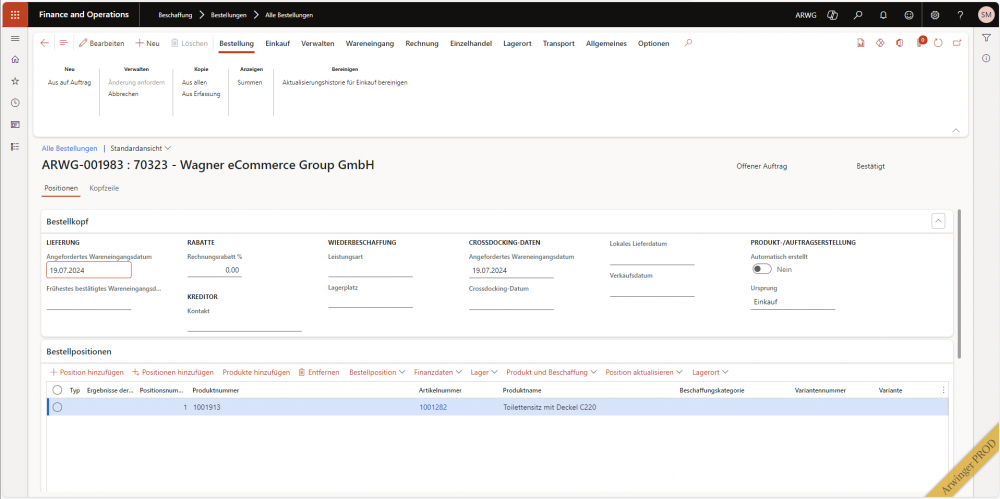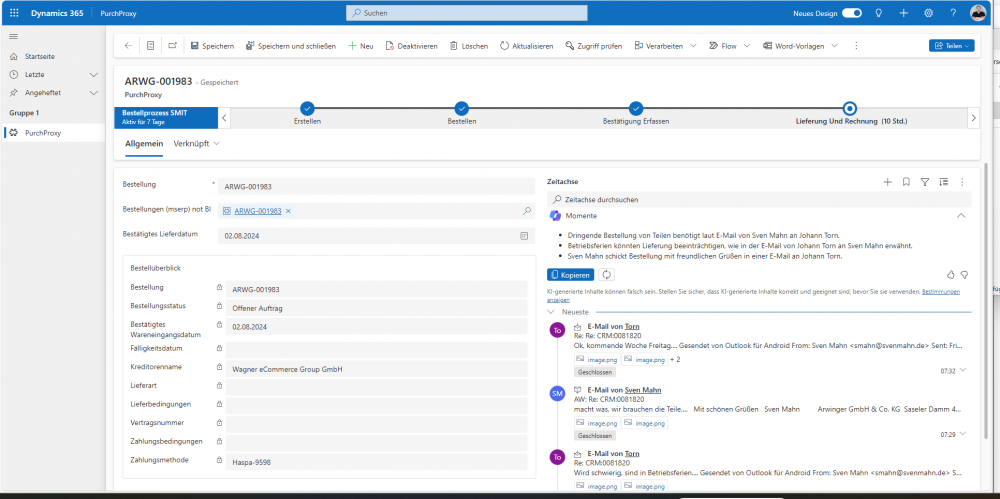
Change of authentication for the Warehouse Management Mobile App
7. June 2024
Microsoft Ignite 2024: Agents, AI & Cybersecurity
2. December 2024
In this post, I'll show you why the days of Microsoft Dynamics 365 Dual Write might be numbered. It's being replaced by something we've christened "Virtual Write", which will revolutionize ERP projects.
The analysis begins in Dynamics 365 Finance and Supply Chain Management. Here we have processes that we know and live by. For example, the procurement process. Orders are created in Dynamics 365 Finance and SCM. It is possible to track the status of individual orders in the system itself. Although you can see whether they are still open, received or invoiced, a comprehensive overview is not provided. This is not the task of the ERP system, which is responsible for optimally and stringently mapping the financial accounting and logistics aspects.

Two key dates of a purchase order are the requested goods receipt date and the confirmed goods receipt date. The confirmed goods receipt date is so relevant in the ordering process because product program planning relies on the goods being available so that they can then go into the production or delivery process.
This date can be tracked via queries. However, it is not very well documented, as it can be changed at any time and moved further back.
On the other hand, there is Microsoft Dynamics 365 Sales. As in Dynamics 365 Finance and SCM, there are entities here, but they are based on Microsoft Dataverse. Dataverse is a cloud-based data platform in which data is stored and can be accessed by various applications within the Microsoft ecosystem.
Forms in Dynamics 365 Sales are based on so-called model-driven apps and their data basis are entities from the Dataverse. Standard features in model-driven apps are the ability to create and integrate business processes and the so-called timeline. Both are not available in this form in Dynamics 365 Finance and SCM.

This integration of the timeline makes it possible to attach email traffic, other communication, appointments, tasks, messages to employees, etc. to an entity. The timeline thus serves to keep track of the information in this data record of the entity.
Nowadays, the information is even processed with the so-called Copilot Moments. Copilot Moments is an AI feature that takes place within the timeline and creates a summary of what communication has actually taken place. This summary of communication helps to make decisions regarding the request very easily and quickly.
So on the one hand we have the undocumented, non-process-driven entity "Order" in Dynamics 365 Finance and SCM, on the other hand Sales, where we can create model-driven apps that include processes and the timeline with their integration towards Outlook. We now connect these two sides - with Virtual Write.
Virtual Write is the best of both worlds and the whole thing is built in a solution in Power Apps. This includes a model-driven app, which contains two tables, especially in terms of the pattern. One is the virtual entity from Dynamics 365 Finance and SCM and the other is a proxy table.
The important thing here is that Dynamics 365 Finance and SCM as well as Sales are connected in one environment.
In this proxy table, we reference the virtual entity to the same key so that we can then use the key to capture data and guide it through a model-driven app in a process-controlled manner.
You can see what this looks like in a specific case here: https://www.youtube.com/watch?v=7_ZTF_zyPX4
With Virtual Write, we connect two elements with each other that could have previously been connected with Dual Right, but when you set it up, it runs stack-based and not synchronously.
One of the main strengths is the maximum flexibility that I have in Virtual Write for my own development, for my own process, for the customized process. The virtual entity comes natively from Dynamics 365 Finance and SCM into the Dataverse environment and the model-driven apps can be connected very easily and generically based on the proxy tables and the integration of the virtual entities.
Virtual entities have certainly been used in a similar form in the past, but the combination described here is unique and revolutionizes the implementation strategy of ERP projects. Only time will tell whether they will still be called ERP projects or platform projects.







